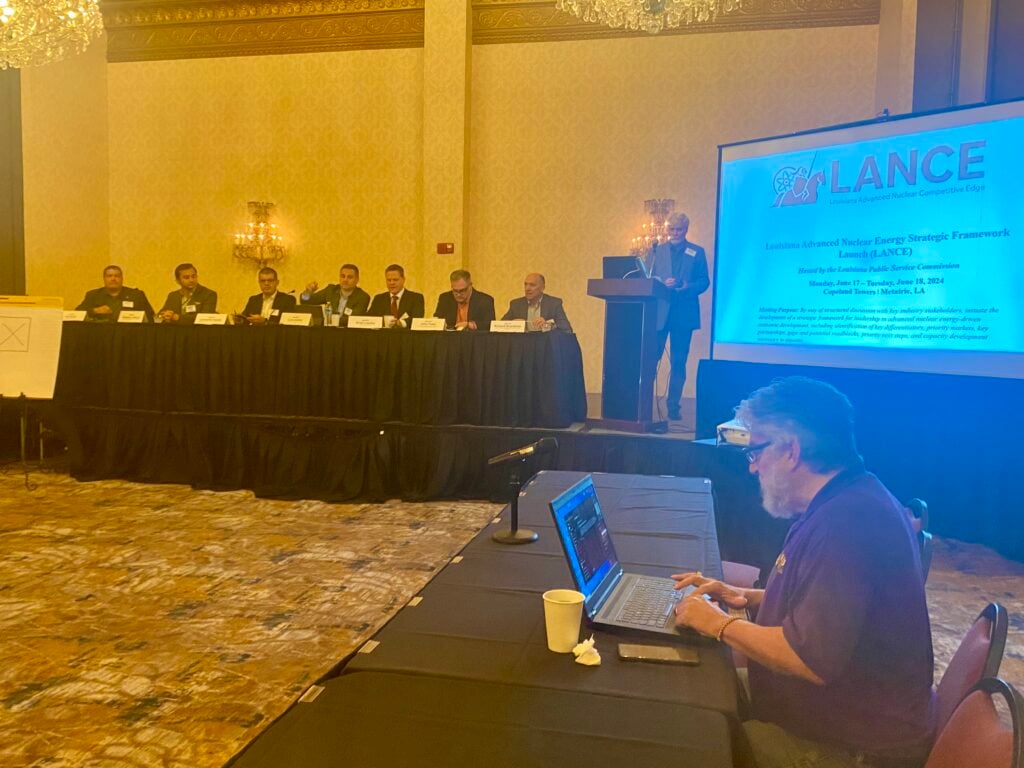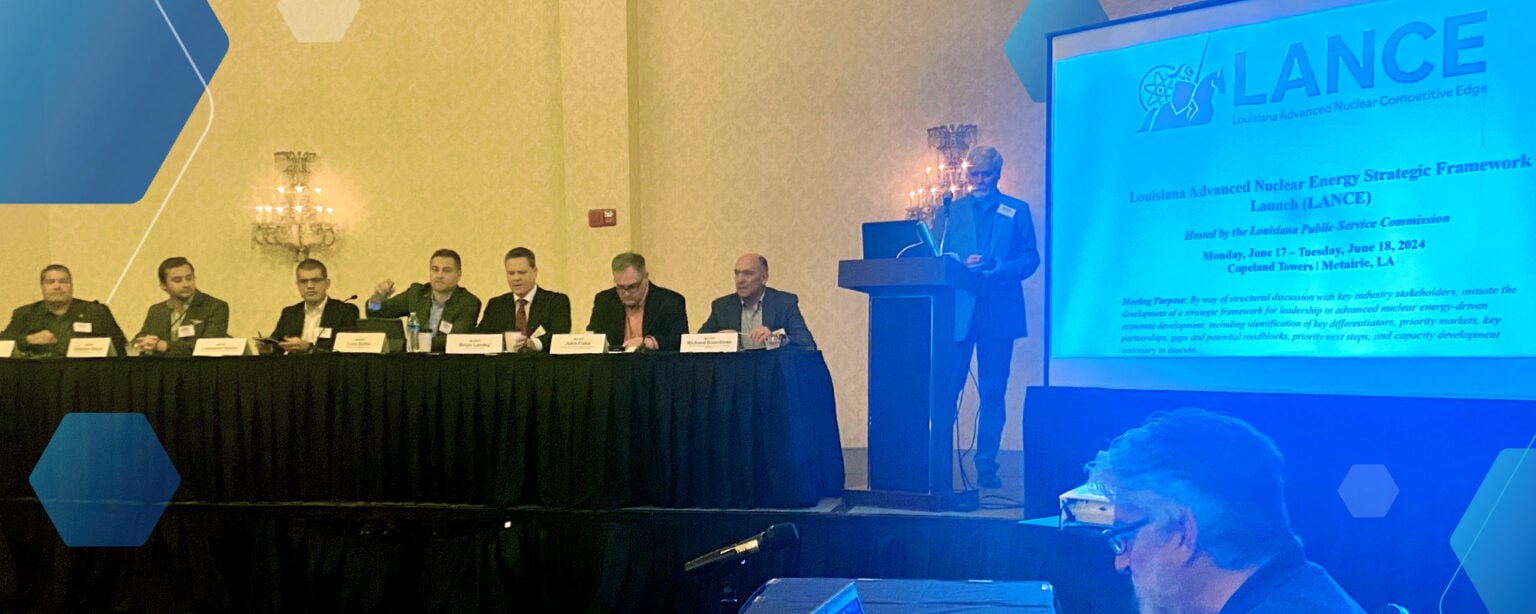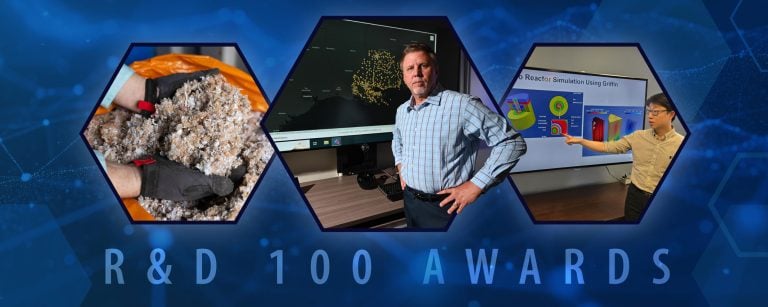Louisiana leaders are working with Idaho National Laboratory’s (INL) Frontiers Initiative to help the state — known for its hydrocarbon and chemical industries — become a national leader in advanced nuclear energy. INL experts will help the state develop a strategic plan to use nuclear energy to power its manufacturing sector and support growing grid-scale electrical demands.
Louisiana is well positioned for advanced nuclear technologies. Chemical and petroleum production is at the core of Louisiana’s manufacturing industry. Louisiana supplies 6.5 gigawatts for onsite industrial heat and power generation, and that industrial energy demand is growing.
“That’s why Louisiana and advanced nuclear will partner in the future,” said Steven Aumeier, senior advisor of strategic programs at INL. “It’s inevitable. It’s smart.”
Louisiana also is a pro nuclear state, said Eric Skrmetta, commissioner of the Louisiana Public Service Commission (LPSC), the agency that regulates utilities in the state.
Entergy Louisiana owns and operates two conventional reactors with approximately 2,000 megawatts of capacity in Louisiana. This spring, the utility formally notified the LPSC of its plan to take initial steps to advance new nuclear technologies in the form of nuclear batteries, microreactors and small modular reactors. This announcement followed a meeting the Frontiers Initiative organized with industry, government and LPSC in February.
The political climate also is favorable. Louisiana Gov. Jeff Landry, a strong supporter of the oil and gas industry, has signaled his support for technology that produces reliable and affordable American-made energy. Former New Orleans Mayor Mitch Landrieu serves as a senior advisor and infrastructure coordinator to President Joe Biden.

Skrmetta said he recognizes the need to facilitate discussions on advanced nuclear technologies given the economic advantages of clean energy generation.
“Fifty percent of our industrials are chemical plants and there’s a demand for net-zero power,” he said. “Louisiana is in a unique position to do this.”
Paul Kjellander, a former Idaho utility commissioner and contractor for INL’s Frontiers Initiative, will lay the groundwork for Louisiana’s strategic plan.
The Frontiers Initiative worked on a similar effort with Wyoming.
In Wyoming, the initiative is working with state officials and University of Wyoming under a memorandum of understanding signed on May 4, where the lab and state agreed to collaborate on nuclear technologies, business and innovation. That collaboration resulted in the development of Wyoming Energy Authority’s advanced nuclear strategic plan. INL, through the Frontiers Initiative, continues to be engaged with Wyoming’s top industry leaders to establish market-leading positions utilizing advanced nuclear technologies.
Kjellander is borrowing from Wyoming’s advanced nuclear energy playbook, drawing on three strategic pillars — generation, value and supply chain — to focus the framework.
“INL’s Frontiers effort has helped set the table for next-mover states to begin plotting a path for advanced nuclear energy deployment,” said Kjellander. “Building from past successes will greatly assist the LPSC as it looks to craft an energy driven economic strategy that includes advanced nuclear energy. We are excited to help Louisiana as it takes strides to address the energy transition and enhance its global competitiveness.”
In June, the LPSC hosted the launch of a strategic plan development under what it calls the Louisiana Advanced Nuclear Competitive Edge. On behalf of the Frontiers Initiative, Kjellander organized panel discussions that included a diverse group of executives from key chemical and oil and gas stakeholders, regulators, manufacture electric utilities, port authority, military representatives, and university professionals.
Participants were unanimous that near-term deployment of advanced nuclear energy should be a priority. But more work is needed to answer key questions critical for planning.
“Having more fuel diversity in our energy portfolio is critical,” said Brian Hobbs, chief executive officer of 1803 Electric Cooperative. “Advanced nuclear can help provide fuel diversity and, importantly, offers sustainable, dispatchable clean energy to provide reliability and economic benefits to the state.”
Larry Hand, vice president of regulatory and public affairs for Entergy Louisiana, said consumer demand for clean energy is driving the need to be competitive. “In order to compete globally, we need clean energy,” he said. “That’s what we hear from our customers.”
“Most of our customers and investors are demanding and expecting decarbonized products,” said Luca Balbo, director of Dow Chemical’s Saint Charles operation site. “We expect many will be willing to pay for at least part of the cost increase, if any.”
There are also geopolitical factors at play.
Russia and China are building nuclear reactors at a rapid pace. China has 27 nuclear reactors under construction — over two and a half times more than any other country. Russia plans to use nuclear reactors to power Arctic ports year-around. The European Union has also adopted rules for taxing imports based on the amount of carbon dioxide that companies emit making those goods.
A key component of the Frontiers Initiative is helping states and U.S. companies win the global competition for low-emission economic activity, or as Aumeier puts it, “the new frontier of global competition.”
“National security interests will continue to grow in influence and impact policy,” said Aumeier. “Economic security is national security. It’s that simple.”





